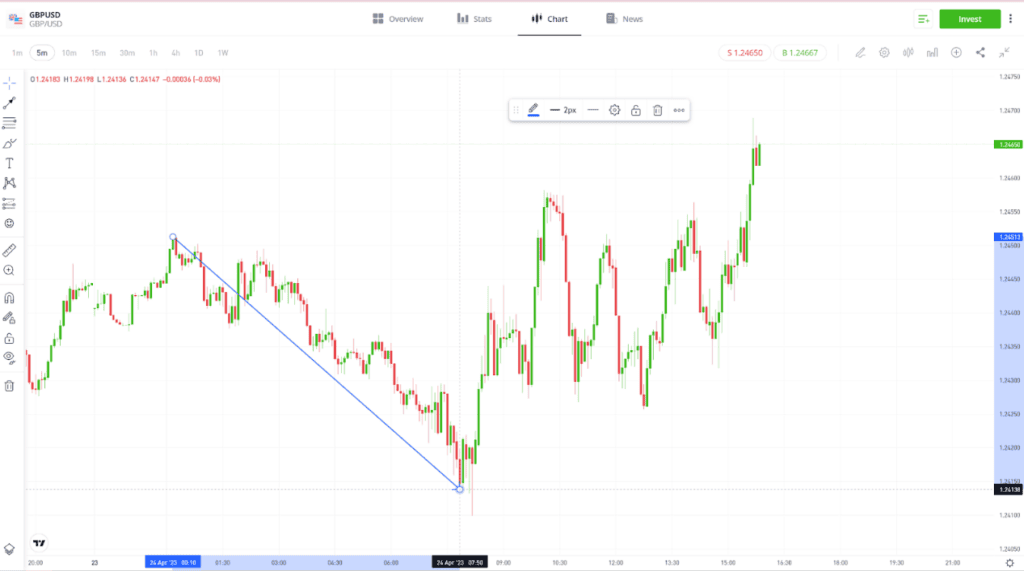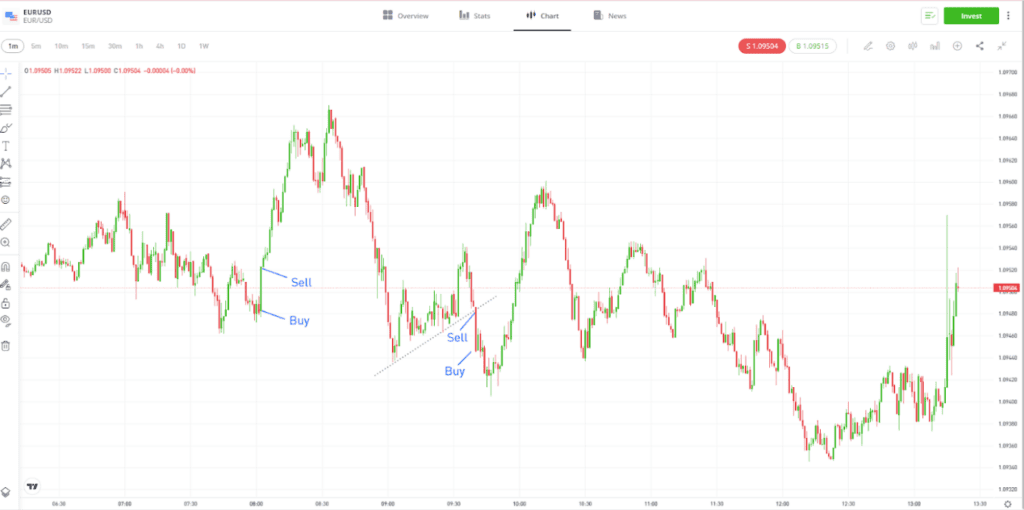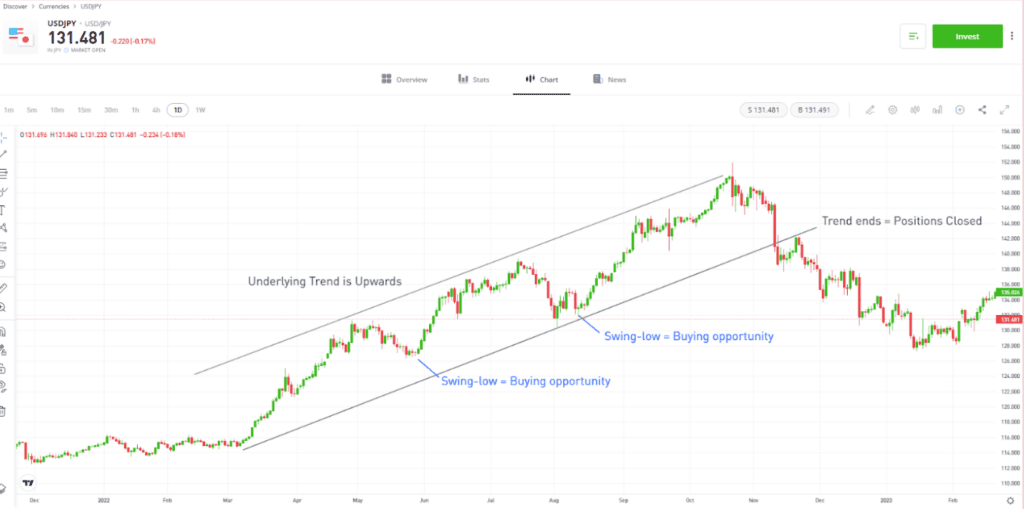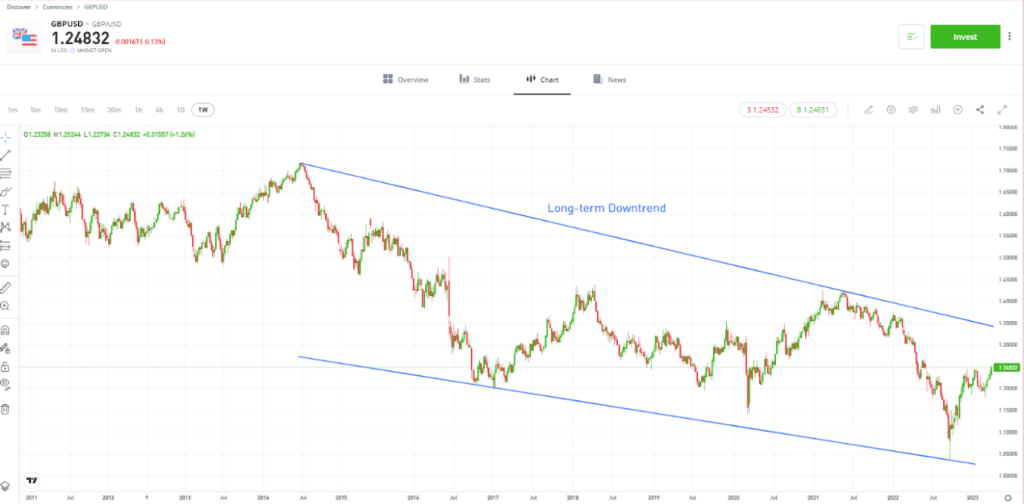Mimo że podstawowe zasady handlu na rynku Forex są stosunkowo proste do opanowania, osiągnięcie oczekiwanych wyników wcale nie jest takie łatwe. Aby dojść do zamierzonego celu inwestycyjnego, ważne jest zrozumienie ruchów cenowych i stworzenie odpowiedniej strategii tradingowej.
Zrozumienie, jak kształtują się ruchy cenowe na rynku walutowym, jest pierwszym krokiem do sukcesu. Kolejny to stworzenie odpowiedniej strategii, która najlepiej dopasuje się do zamierzonych celów inwestycyjnych, tolerancji ryzyka i sytuacji na rynku.Dowiedz się, jak wybrać strategię tradingową Forex w zależności od konkretnej sytuacji i jak najlepiej wykorzystać jej potencjał.
Twoja strategia handlowa na rynku Forex powinna uwzględnić kilka ważnych kwestii. Bardzo istotne jest wybranie odpowiedniego momentu na otworzenie (punkt wejścia) i zamknięcie danej pozycji (punkt wyjścia).
Wielu inwestorów decyduje się również na użycie dodatkowych strategii i narzędzi pozwalających na efektywne zarządzanie ryzykiem, takich jak dywersyfikacja portfela, hedging, Stop Loss czy Take Profit.
To, jakie pary walutowe kupujesz i sprzedajesz, powinno być również zgodne z tym, jak chcesz, żeby wyglądał Twój portfel inwestycyjny – zarówno pod względem rodzaju posiadanych aktywów, jak i ich dywersyfikacji oraz poziomu ryzyka.
Wybierając daną strategię, nie zapomnij o cierpliwości, wytrwałości i dyscyplinie – tylko w ten sposób będziesz w stanie osiągnąć zamierzone cele.
Wskazówka: Odpowiednia psychologia inwestowania i rozwijanie właściwego sposobu myślenia mogą pomóc Ci radzić sobie ze stratami, uniknąć sprzedawania aktywów w panice i konsekwentnie dążyć do obranego celu inwestycyjnego.

Czym są strategie handlowe Forex?
Strategia handlowa Forex to zbiór zasad i narzędzi, jakie inwestor lub trader wykorzystuje do podejmowania decyzji handlowych na rynku Forex. Wybrana strategia Forex powinna określać, po jakiej cenie chcesz kupić lub sprzedać wybraną parę walutową, jak długo chcesz trzymać na niej pozycję i kiedy ją zamknąć, aby zoptymalizować swoje zwroty.
Wszystkie strategie Forex kierują się oczywiście podstawową zasadą tradingu: „kup tanio i sprzedaj drogo”. Niemniej jednak każdy inwestor dąży do tego celu swoją własną drogą, wybierając narzędzia i strategie, które najlepiej wpasowują się do jego indywidualnych celów i stylu inwestycyjnego.
Wybór odpowiedniej strategii Forex ma na celu podejmowanie bardziej świadomych decyzji handlowych, lepsze zarządzanie ryzykiem i zwiększenie szans na osiągnięcie sukcesu w tradingu walutowym.
Wskazówka: Twoja strategia tradingowa na rynku Forex powinna dążyć do spełnienia wybranych przez Ciebie celów inwestycyjnych krótko- i długoterminowych oraz ilości czasu, jaki jesteś w stanie poświęcić swoim inwestycjom.

Przykłady strategii Forex
Dlaczego istnieje wiele różnych strategii Forex? Dlatego, że każdy trader ma swoje własne cele, preferencje, zdolności kapitałowe, poziom wiedzy i doświadczenia. Co więcej, różne sytuacje rynkowe wymagają różnych strategii handlu – innych narzędzi używa się w przypadku zakłóceń, a innych, gdy rynek jest stabilny.
Strategie handlowe Forex różnią się zatem w zależności od preferencji inwestorów i od tego, jak wygląda aktualna sytuacja na danym rynku.
To, że wybrałeś pewną strategię, nie oznacza, że nie możesz jej zmienić, kiedy trendy Forex się odwrócą. Wręcz przeciwnie – zawsze staraj się dopasować swoją strategię tradingową do tego, jak kształtują się ceny, przewidywania i nastroje.
Aby wiedzieć, jaką strategię Forex wybrać, najpierw musisz poznać ich podstawowe rodzaje.
Bądź (…) elastyczny i nie zamykaj się na możliwość zamiany strategii, jeśli sytuacja na rynku będzie tego wymagała.
Strategia „day trading” na rynku Forex
Day trading na rynku Forex to forma aktywnego handlu, w której inwestor otwiera i zamyka pozycje walutowe w ciągu jednego dnia handlowego. Day traderzy starają się osiągnąć zyski na krótkoterminowych ruchach cenowych na rynku walutowym. Wymaga to szybkich reakcji i podejmowania decyzji w krótkim czasie.
Ograniczenie czasu, przez jaki trader posiada daną parę walutową i zamykanie posiadanych pozycji, zanim rynek zakończy swoją dzienną sesję, pomaga zabezpieczyć się przed gwałtownymi wahaniami cenowymi i może ochronić Cię przed zbytnimi stratami.
Wskazówka: Otwierając pozycję przy day tradingu, możesz ustawić jednocześnie poziom Stop Loss. Jeśli cena dojdzie do jego poziomu, Twoja pozycja zostanie automatycznie zamknięta, co pozwoli Ci lepiej kontrolować ewentualne straty.
Day traderzy często polegają na analizie technicznej, używając wskaźników technicznych, formacji świecowych i innych narzędzi do identyfikacji krótkoterminowych trendów, poziomów wsparcia i oporu oraz sygnałów wejścia i wyjścia z pozycji.
Spójrz na wykres poniżej pokazujący spadek ceny GBP/USD zanotowany 24 kwietnia 2023 między 00:00 a 07:50 rano. Traderzy posiadający otwarte pozycje na tej parze walutowej mogli w tym czasie zanotować straty, przed którymi mogła ich ochronić strategia day trading.

Wyniki osiągnięte w przeszłości nie są wyznacznikiem przyszłych wyników.
Źródło: eToro
Skalpowanie na rynku Forex
Niektóre platformy tradingowe zezwalają na handel Forex przy użyciu skalpowania. Jest to strategia, w której inwestor otwiera i zamyka wiele różnych pozycji w ciągu bardzo krótkiego czasu – zwykle w ciągu kilku sekund, minut lub godzin. Celem skalpowania jest osiągnięcie nawet niewielkich zysków na krótkoterminowych ruchach cenowych.
Jak wybrać pary walutowe najbardziej odpowiednie do skalpowania? Podobnie jak w przypadku day tradingu, efektywna strategia skalpowania na rynku Forex wymaga umiejętnej analizy technicznej, wykorzystania wskaźników i wykresów udostępnianych przez brokera.
Zgodnie z zasadami Regulaminu eToro, scalping uważany jest za niedozwoloną technikę inwestycyjną.
Aby dowiedzieć się więcej na temat tych zasad, należy zapoznać się z naszym Regulaminem, korzystając z poniższego łącza: https://www.etoro.com/pl/customer-service/terms-conditions/.
Wykres poniżej pokazuje możliwości wykorzystania skalpingu do kupna i sprzedaży pary EUR/USD. W ciągu zaledwie kilku godzin pojawiły się wyraźne trendy rosnące i spadające w jej cenie, które traderzy dokładnie śledzący rynek są w stanie użyć dla swoich korzyści.

Wyniki osiągnięte w przeszłości nie są wyznacznikiem przyszłych wyników.
Źródło: eToro
Strategia „swing trading” na rynku Forex
Oparta o silne trendy cenowe strategia swingowania to kolejny sposób, w jaki możesz handlować na rynkach walutowych. Słowo „swing” odnosi się w niej do cenowych punktów zwrotnych, czyli momentów, w których cena danej pary walutowej zmienia swój trend.
Używając strategii swing trading, inwestorzy na rynku Forex zwykle utrzymują otwarte pozycje na wybranych parach walutowych nieco dłużej niż przy skalpowaniu i day tradingu, czekając, aż pojawi się swing w ich trendzie cenowym.
Swing cenowy pomaga zidentyfikować potencjalne punkty wejścia i wyjścia z pozycji. Dobry moment na kupno danej pary walutowej pojawia się, gdy jej cena osiągnie lokalne minimum (ang. dip), a dobry moment na jej sprzedaż to jej lokalne maksimum cenowe (ang. top).
Wskazówka: Strategia swing trading wymaga zwykle wykonywania mniejszej liczby transakcji i dłuższego trzymania pozycji. Dzięki temu lepiej wpasowuje się w pasywny styl inwestowania.
Jak długo trzymać otwartą pozycję przy strategii swing trade? Doświadczeni traderzy zwykle robią to tak długo, aż cena zacznie się stabilizować.
Wykres poniżej pokazuje swingi trendów, które pojawiły się w okresie 2022-2023 dla pary walutowej USD/JPY. Zidentyfikowanie lokalnych gór i dołków ułatwiłoby podjęcie odpowiedniej decyzji kupna lub sprzedaży.

Wyniki osiągnięte w przeszłości nie są wyznacznikiem przyszłych wyników.
Źródło: eToro
Trading pozycyjny na rynku Forex
Strategia „position trading” – znana również jako trading pozycyjny – opiera się na szukaniu większych trendów cenowych na rynku Forex i wykorzystaniu ich do zajęcia średnio i długoterminowych pozycji (od kilku tygodni do kilku lat) na parach walutowych w celu zmaksymalizowania zysków.
Aby trading pozycyjny przyniósł zamierzone rezultaty, konieczne jest oparcie go o analizę fundamentalną mającą na celu zidentyfikowanie długoterminowych trendów i kierunków rynku. Służą do tego wskaźniki makroekonomiczne, polityka monetarna banków centralnych i inne informacje o światowych rynkach walutowych.
Biorąc pod uwagę, że strategia „position trading” zakłada największą pasywność i najdłuższy horyzont czasowy wśród dotychczas omawianych strategii handlu Forex, można powiedzieć, że bardziej przypomina ona inwestycje niż trading.
Spójrz na tygodniowy wykres cenowy GBP/USD i zobacz, jak mógłby wyglądać trading pozycyjny dla tej pary walutowej:

Wyniki osiągnięte w przeszłości nie są wyznacznikiem przyszłych wyników.
Źródło: eToro
Jak wybrać odpowiednią strategię tradingową na rynku Forex
Dobranie strategii do sytuacji na rynku Forex i do trendów cenowych danej pary walutowej to podstawa sukcesu. Równie ważne jest trzymanie ręki na pulsie i – jeśli zaistnieje taka potrzeba – zastąpienie obranej strategii inną. Elastyczność, poszerzanie wiedzy i zdolność do zmiany sposobu myślenia przy nowych warunkach rynkowych mogą pomóc Ci osiągnąć lepsze rezultaty.
Wybierając odpowiednią dla siebie strategię tradingową Forex, nie zapomnij o efektywnym zarządzaniu ryzykiem i korzystaj z narzędzi, jakie tego rodzaju handel ma do zaoferowania (np. zlecenia Stop Loss). Zanim zdecydujesz się na użycie bardziej zaawansowanych narzędzi takich jak dźwignia, upewnij się, że rozumiesz, jak działają i przelicz nie tylko możliwe zyski, ale i potencjalne straty.
Wiedza to najlepsze narzędzie władzy
Bill Gates
Kolejny czynnik, jaki warto wziąć pod uwagę, opracowując swój styl handlu walutowego, to ilość czasu, jakim dysponujesz. Wśród przedstawionych strategii są takie, które wymagają większego zaangażowania i nadzoru ze strony inwestora niż inne. Day trading czy skalpowanie nie zadziałają, jeśli nie poświęcisz im wystarczająco dużo czasu.
Jeśli obawiasz się zainwestować własny kapitał na rynku Forex możesz najpierw poćwiczyć kupowanie par walutowych na koncie demonstracyjnym, oferowanym przez różne platformy brokerskie. W ten sposób będziesz miał możliwość nabyć doświadczenie i wypróbować różne strategie tradingowe bez ryzyka strat.

Podsumowanie
Przy odpowiedniej strategii, handel na rynku Forex powinien Ci sprawić mniej trudności. Możesz zacząć od jednej, wypróbować ją na wybranej parze walutowej i – jeśli nie przyniesie ona oczekiwanych wyników – zmienić ją na inną. Możesz również używać kilku różnych strategii jednocześnie w zależności od par walutowych, jakie posiadasz.
Być może niektóre strategie handlowe polubisz bardziej od innych – czy to ze względu na ich większą intuicyjność, czy lepsze rezultaty. Bądź jednak elastyczny i nie zamykaj się na możliwość ich zamiany, jeśli sytuacja na rynku będzie tego wymagała.
Pamiętaj również o tym, żeby wybraną strategię oprzeć o jak najlepszą analizę techniczną lub fundamentalną, na bieżąco sprawdzać sytuację na rynkach walutowych i nauczyć się korzystać z narzędzi, jakie udostępnia Ci Twój broker.
Odwiedź naszą Akademię eToro, aby dowiedzieć się więcej o parach walutowych i handlu na rynku Forex.
Najczęściej zadawane pytania
- Ile kosztuje handel na rynku Forex?
-
To, jakie koszty wynikają z kupowania i sprzedawania par walutowych, zależy od wybranego przez Ciebie domu maklerskiego lub platformy tradingowej. W większości wypadków powinieneś liczyć się między innymi z opłatą za ewentualne przewalutowanie środków, a także kosztami spreadu, czyli różnicą między ceną sprzedaży (bid) a ceną kupna (ask) określonej pary walutowej. Weź również pod uwagę prowizję z tytułu wypłaty środków.
- Czy rynek Forex jest bezpieczny dla inwestorów?
-
Handel na rynku Forex to jeden z najbezpieczniejszych rodzajów przeprowadzania transakcji walutowych oraz generowania możliwych przychodów, pod warunkiem że wybierzesz odpowiedniego brokera, który zapewni Twoim aktywom, środkom pieniężnym i danym osobowym odpowiednią ochronę. Bezpieczeństwo rynku Forex nie oznacza jednak, że nie można na nim stracić zainwestowanego kapitału. Twoje wyniki handlowe zależą jednak w dużej mierze od Twoich decyzji inwestycyjnych.
- Jak odpowiednio ustawić poziom Stop Loss przy strategii day trading?
-
Decydując, na jakim poziomie ustawić Stop Loss, warto przeprowadzić analizę techniczną i na jej podstawie zidentyfikować istotne poziomy wsparcia i oporu. Stop Loss najczęściej umieszcza się poniżej (dla pozycji długich) lub tuż powyżej (dla pozycji krótkich) tych poziomów, co zwiększa szanse na ograniczenie strat. Gdy nabędziesz doświadczenie, będziesz mógł ustawić poziom Stop Loss na podstawie dodatkowych narzędzi technicznych, takich jak wstęgi Bollingera, poziomy Fibonacciego czy średnie ruchome.
Niniejsze treści mają charakter wyłącznie edukacyjny i nie powinny być traktowane jako porada inwestycyjna, osobista rekomendacja, oferta lub zachęta do kupna bądź sprzedaży jakichkolwiek instrumentów finansowych.
Podczas przygotowywania niniejszego materiału nie uwzględniano konkretnych celów inwestycyjnych ani sytuacji finansowej. Nie został on sporządzony zgodnie z wymogami prawnymi i regulacyjnymi dotyczącymi promowania niezależnych badań. Nie wszystkie instrumenty finansowe i usługi, o których mowa, są oferowane przez eToro, a wszelkie odniesienia do historycznych wyników instrumentów finansowych, indeksów lub konfekcjonowanych produktów inwestycyjnych nie stanowią gwarancji przyszłych wyników i nie należy ich w ten sposób interpretować.
eToro nie gwarantuje oraz nie ponosi odpowiedzialności względem dokładności lub kompletności treści niniejszego przewodnika. Zanim zainwestujesz jakikolwiek kapitał, upewnij się, że rozumiesz ryzyko związane z jego obrotem. Nigdy nie ryzykuj więcej niż jesteś gotów stracić.


